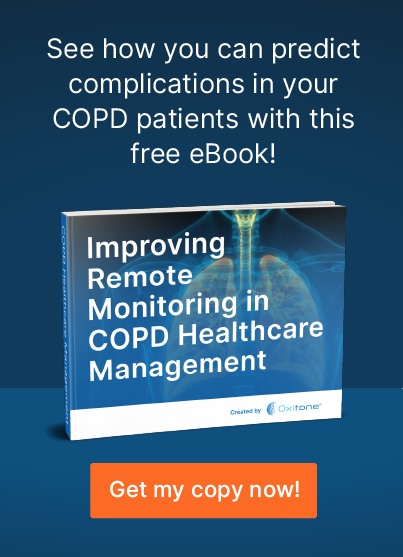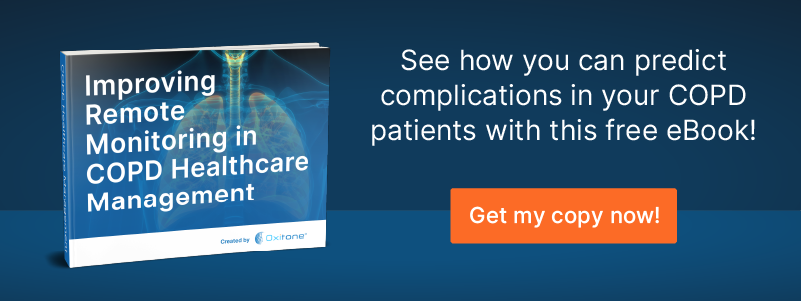The prediction and early detection of complications for COPD patients with continuous monitoring to lower readmission rates
Chronic obstructive pulmonary disease (COPD) is the third leading cause of death by disease worldwide and has a thirty-day readmission rate of 22.6%. Since COPD patients require close monitoring and follow-up, they are a vital area of concern at primary care practices. Doctors and patients both want to avoid hospital readmissions for patients with COPD. The high readmission rate among COPD patients results in increased costs and burden of care.
Continuous remote patient monitoring (CRPM) allows for earlier detection of COPD complications, thereby reducing hospitalizations and readmissions among COPD patients. Through the prediction and early detection of COPD exacerbations and complications, CRPM can better prevent readmission among COPD patients than traditional patient monitoring techniques. By better engaging patients in their care and alerting doctors to critical changes in their vitals, CRPM improves follow-up rates and reduces the risk of COPD readmissions.
Common Complications of COPD
COPD is a disabling disease with the potential for high costs and complications. The latter can threaten patient health and drastically reduce quality of life, making their prevention an essential concern for the doctors who care for COPD patients.
The long-term risks of COPD include lung cancer, airway collapse, confusion or memory loss, and depression due to decreased physical abilities. As a result, COPD patients require significantly more medical care than the average person. In 2010 alone, COPD patients represented 1.5 million emergency department visits and 10.3 million physicians’ office visits.
High medical care usage among COPD patients results in high costs for hospitals and clinics. Preventing exacerbations and complications of COPD could significantly reduce these costs because more than 70% of COPD-related healthcare costs are due to emergency hospitalizations.
The causes of many COPD exacerbations are preventable, especially when patients’ vital signs are being monitored around the clock. Around 50 to 75% of all COPD exacerbations have common causes, like the flu, pneumonia, or even the common cold. The COVID-19 pandemic presents additional risks for COPD patients, as having COPD is known to increase the risk of severe illness with SARS-CoV-2.
How CRPM Improves Outcomes in COPD Patients
CRPM is a new type of patient monitoring that involves wearing digital medical devices and other technology. Unlike traditional patient monitoring, which relies on follow-up visits and infrequent data collection, CRPM allows doctors to access a steady stream of information about their patients’ vital signs, without sacrificing appointment time.
CRPM helps patients with COPD and other chronic diseases in three primary ways: by improving quality of life, offering higher quality care, and reducing the costs and risks associated with care for their condition. When it comes to managing COPD specifically, CRPM achieves this by predicting complications and exacerbations before they happen, reducing the need for emergency hospitalizations.
Oxygen saturation, or SpO2, is thought to be predictive of exacerbations in COPD patients. Unlike traditional pulse oximetry, which only shows snippets of a patient’s SpO2, CRPM allows doctors to receive a continuous flow of patient data of oxygen saturation and other factors predictive of COPD exacerbations, allowing them to identify and treat potential exacerbations early and avoid mistaking natural fluctuations for a severe complication.
By asking patients to wear a digital medical device outside of appointments, doctors can improve follow-up by encouraging patients to take on a more active role in their care and disease management. CRPM empowers COPD patients to feel more in control of their health and encourages them to follow up more often and more regularly than with traditional patient monitoring.
How Oxitone Can Help
Oxitone is a wearable medical device that collects a steady stream of information about patients’ vital signs, stress, etc. to help doctors predict complications, reduce hospitalizations, and provide more comprehensive care. Digital health technology like Oxitone has been proven to improve the engagement of COPD patients, as they are empowered to take on a more active role in self-management.
One of the most critical functions of Oxitone for the management of COPD patients is its ability to provide continuous pulse oximetry metrics. Digital wearable pulse oximetry can measure SpO2 with greater frequency than the traditional pulse oximetry used in the doctor’s office, allowing doctors to spot potential exacerbations before they begin and avoid unnecessary hospitalizations due to natural fluctuations.
Unlike other medical technologies, Oxitone not only measures SpO2 but can also collect continuous data on sleep, physiological stress, behavior, and more. This can improve the lives of COPD patients by helping them identify potential triggers. As a result, doctors can receive a more complete picture of their patients’ health, and COPD patients can manage possible exacerbations and complications before they begin, preventing emergencies and hospitalizations that could result in exorbitant healthcare costs and decreased quality of life.
Here at Oxitone, we boost value-based healthcare by delivering extraordinary patient, clinical, and economical outcomes at reduced medical utilization and cost. Patients need a prompt response to emergencies. Physicians need an easy and timely follow-up with patients. Our mission is to transform chronic disease management and help save lives worldwide.
Let’s save lives together! To see how we help remote patient monitoring companies and physicians improve the management and care of high-risk patients, contact us today!


